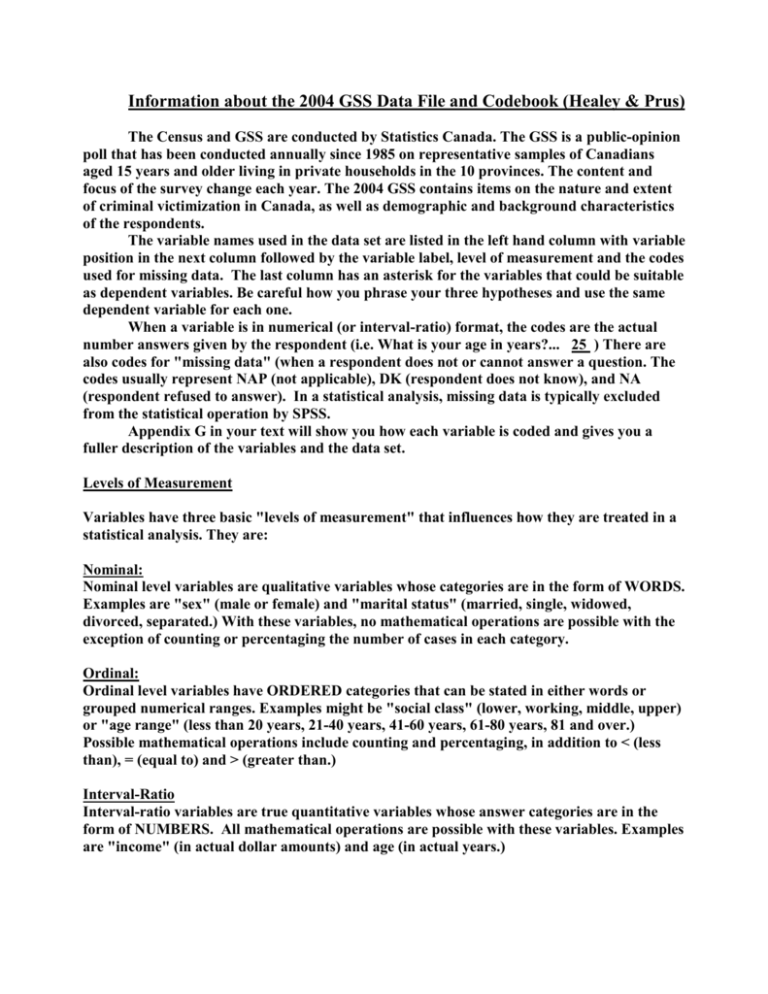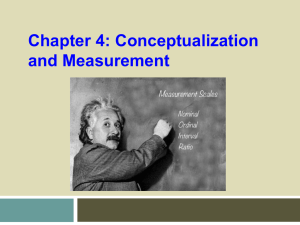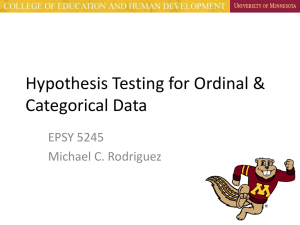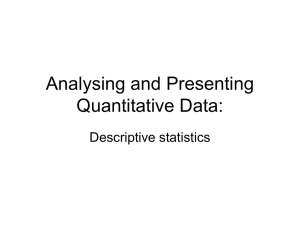List of variables in the 2004 GSS data set
advertisement

Information about the 2004 GSS Data File and Codebook (Healey & Prus) The Census and GSS are conducted by Statistics Canada. The GSS is a public-opinion poll that has been conducted annually since 1985 on representative samples of Canadians aged 15 years and older living in private households in the 10 provinces. The content and focus of the survey change each year. The 2004 GSS contains items on the nature and extent of criminal victimization in Canada, as well as demographic and background characteristics of the respondents. The variable names used in the data set are listed in the left hand column with variable position in the next column followed by the variable label, level of measurement and the codes used for missing data. The last column has an asterisk for the variables that could be suitable as dependent variables. Be careful how you phrase your three hypotheses and use the same dependent variable for each one. When a variable is in numerical (or interval-ratio) format, the codes are the actual number answers given by the respondent (i.e. What is your age in years?... 25 ) There are also codes for "missing data" (when a respondent does not or cannot answer a question. The codes usually represent NAP (not applicable), DK (respondent does not know), and NA (respondent refused to answer). In a statistical analysis, missing data is typically excluded from the statistical operation by SPSS. Appendix G in your text will show you how each variable is coded and gives you a fuller description of the variables and the data set. Levels of Measurement Variables have three basic "levels of measurement" that influences how they are treated in a statistical analysis. They are: Nominal: Nominal level variables are qualitative variables whose categories are in the form of WORDS. Examples are "sex" (male or female) and "marital status" (married, single, widowed, divorced, separated.) With these variables, no mathematical operations are possible with the exception of counting or percentaging the number of cases in each category. Ordinal: Ordinal level variables have ORDERED categories that can be stated in either words or grouped numerical ranges. Examples might be "social class" (lower, working, middle, upper) or "age range" (less than 20 years, 21-40 years, 41-60 years, 61-80 years, 81 and over.) Possible mathematical operations include counting and percentaging, in addition to < (less than), = (equal to) and > (greater than.) Interval-Ratio Interval-ratio variables are true quantitative variables whose answer categories are in the form of NUMBERS. All mathematical operations are possible with these variables. Examples are "income" (in actual dollar amounts) and age (in actual years.) List of variables in the 2004 GSS data set (see AppendixG for more) Suitable as Variable acmyr actlimit agegr5 discrim drr_q110 drr_q120 dwelc dwellown edu10 famtype hal_q120 Position Label 1 2 Main activity in past year Long-term health problem limits activity 3 Age group (in years) 4 5 6 Victim of discrimination in past 5 yrs Past month how often you drink alcohol # times you had 5+ drinks past month 7 Dwelling type 8 9 10 11 Dwelling owned by hhld member Highest level of education: 10 grps Type of family structure Any difficulty hear/see/walking/etc. Measurement Missing Dependent Level Values Variable Nominal Nominal * Ordinal Nominal * Ordinal Scale 97 * Nominal Nominal * Ordinal Nominal Ordinal hlthstat 12 State of health Ordinal * hsdsizec 13 Household size Scale * incm incmhsd lanhsdc lifevict live_neigh 14 15 Annual personal income Total household income 16 Household language 17 18 Ever been a victim of crime How long lived in current neighbourhood Ordinal 98, 99 * Ordinal 98, 99 * Nominal Nominal Ordinal * luc_rst 19 Urban/Rural indicator Nominal marstat 20 Marital status Nominal med_depress msvic 21 22 numevact_c Take medication for depression Most serious victimization in past yr Nominal Nominal Average number of 23 evening activities respondent goes out Scale * for in a month. phr_q110 Your neighbourhood 24 has __ crime than Ordinal other phr_q120 Past 5 yrs your 25 neighbourhood crime Ordinal has: phr_q130 phr_q190 phr_q230 phr_q250 phr_q260 phr_q320 phr_q330 phr_q340 phr_q400 phr_q410 26 27 28 29 30 31 32 33 34 35 You walking alone at night in your area Home alone at night you feel: Local police are approachable Local police good at ensuring safety Local police treat people fairly Criminal courts help victims Criminal courts good at sentencing Criminal courts ensure a fair trial Court sentences are too severe Prison system at controlling prisoners Ordinal * Ordinal * Ordinal Ordinal Ordinal Ordinal Ordinal Ordinal Ordinal Ordinal phr_q420 36 phr_q510 Prison system at reforming prisoners Ordinal Prison system 37 releasing safe Ordinal offenders phr_q520 phr_q990 38 39 Prison system at parolling offenders Satisfied with your personal safety Ordinal Ordinal prv 40 Province of residence relig6 41 Religion (6 categories) Nominal rl_q105 sex stalking vismin wght_per wkwehr_c yrarri Variables in the working file 42 Importance of your religious beliefs 43 Sex 44 Respondent reported stalking incident Nominal Ordinal Nominal Nominal 45 Visible minority status Nominal 46 47 48 Person Weight (adjusted) # of hours usually worked per week Yr you came to live permanent in Cda Scale Scale Ordinal *







